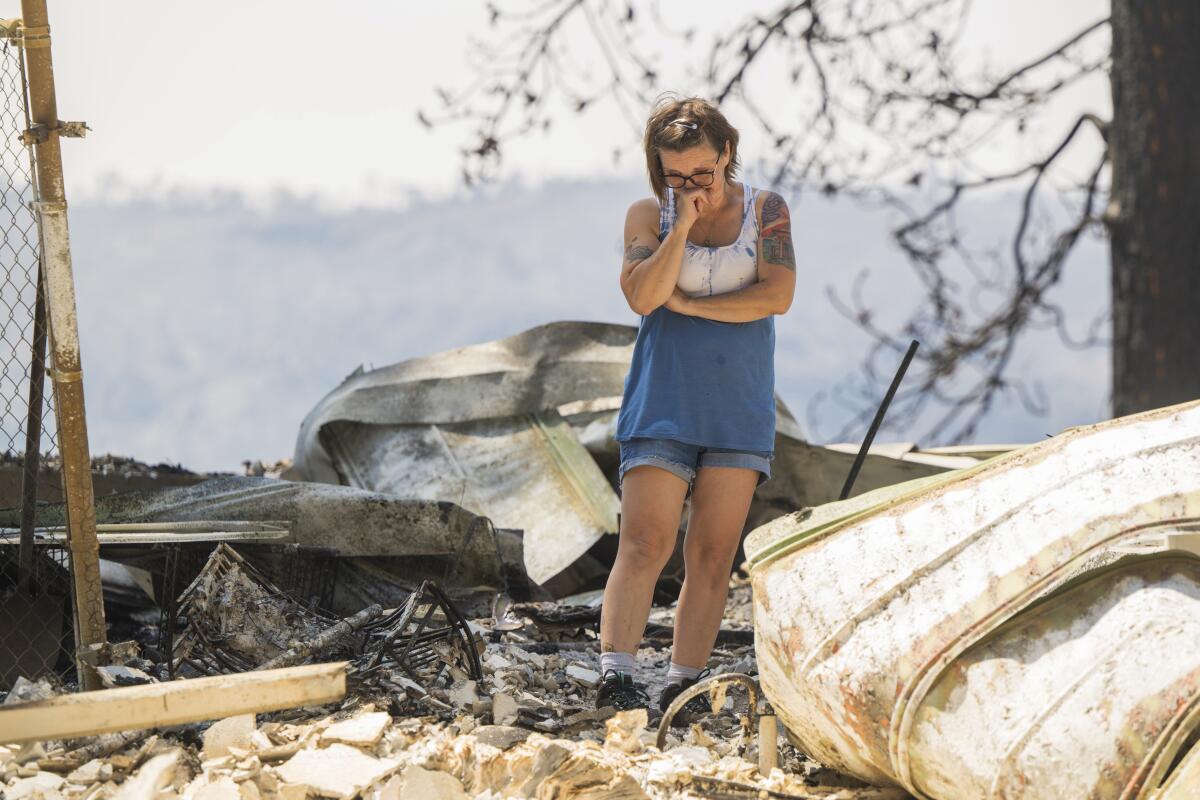Firefighters worry heat, thunderstorms could fuel the already massive Park fire

- Share via
Firefighters battling to contain the raging Park fire in Northern California got a brief respite Friday morning thanks to low clouds and slightly lower temperatures that could help slow the spread of the fourth-largest wildfire in state history.
But the break is expected to be short.
By midday, the 6,375 firefighters on the ground north of Chico in Butte County were expected to face temperatures above 100 degrees, possible thunderstorms arriving in the evening and erratic winds that would hamper their mission to contain the flames.
For the weekend, firefighters expect more of the same challenges, with triple-digit temperatures continuing for the next few days and lightning strikes during thunderstorms that threaten to fan the blaze.
“The main thing that they’re worried about out there is the change of weather,” said Capt. Jim Evans, part of the multiagency team assigned to the Park fire under the California Department of Forestry and Fire Protection, or Cal Fire.
According to the National Weather Service, temperatures in the area are expected to reach 101 degrees Saturday and 102 Sunday.

By Friday morning, the Park fire had burned 399,437 acres and destroyed 542 structures, according to Cal Fire.
The flames have rapidly spread across Butte, Plumas, Shasta and Tehama counties, fed by thick, dry vegetation parched by this summer’s intense heat waves, fire officials said.
As of Friday morning, the fire was 24% contained.
But fire officials said they’re facing multiple challenges in their fight, including low humidity, the possibility of erratic winds and steep topography that has made radio communication between crews on the ground difficult.
A perfect storm of hot, dry winds, untouched brush and remote topography has fueled explosive growth of the Park fire north of Chico, now over 350,000 acres.
To reach some of the most difficult to access areas — impossible to get to via vehicle — fire officials have resorted to transporting firefighters via helicopters.
Some of the crews are expected to spend days on the front lines, where they will have supplies flown in for them.
Evans said a chance of thunderstorms this weekend raised concern that lightning strikes could ignite fires in areas already extinguished by firefighters.
Thunderstorms are also expected to bring erratic winds, making the fire’s progress and behavior difficult to anticipate, Evans said.
According to Cal Fire, crews are spread out across 200 miles of active fire front.

Cal Fire has also directed some of its attention toward protecting Lassen Volcanic National Park, northeast of the fire. Crews have built a direct line north of Howard Creek and installed a secondary line through the park from Viola Mineral Road to Highway 89 to keep flames from moving deep into the forest.
California is infamous for its destructive wildfire seasons. This year has been among the worst, with more than 4,700 individual fires burning more than 772,000 acres across the state.
The Park fire, believed to have been sparked by a man who was seen pushing a burning car into a gully, has by far been the largest so far.
In Kern and Tulare counties, the Lightning Complex fire has burned more than 91,000 acres since it was ignited July 13.
In Santa Barbara County, the Lake fire on Friday was 95% contained after burning more than 38,000 acres. And the Hill fire in Humboldt and Trinity counties has burned more than 7,200 acres.
In Riverside County, the Nixon fire had burned 5,222 acres and was 21% contained as of Friday morning, per Cal Fire.
More to Read
Sign up for Essential California
The most important California stories and recommendations in your inbox every morning.
You may occasionally receive promotional content from the Los Angeles Times.












